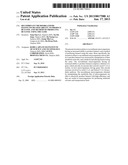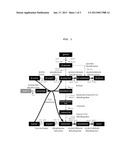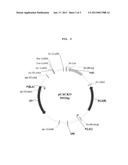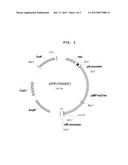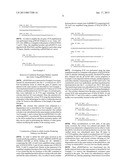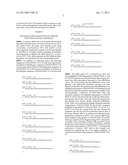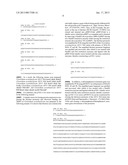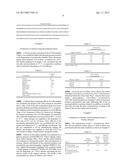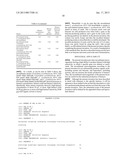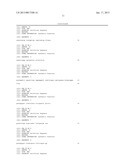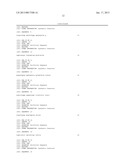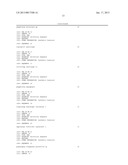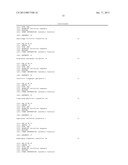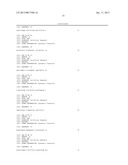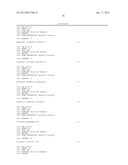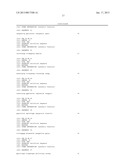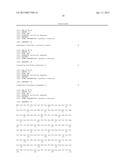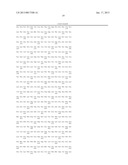Patent application title: RECOMBINANT MICROORGANISMS HAVING INCREASED ABILITY TO PRODUCE BUTANOL AND METHOD OF PRODUCING BUTANOL USING THE SAMEAANM Lee; Sang YupAACI DaejeonAACO KRAAGP Lee; Sang Yup Daejeon KRAANM Jang; Yu-SinAACI DaejeonAACO KRAAGP Jang; Yu-Sin Daejeon KRAANM Lee; Jin YoungAACI IncheonAACO KRAAGP Lee; Jin Young Incheon KRAANM Lee; Joung MinAACI Gangwon-doAACO KRAAGP Lee; Joung Min Gangwon-do KRAANM Park; Jin HwanAACI DaejeonAACO KRAAGP Park; Jin Hwan Daejeon KR
Inventors:
Sang-Yup Lee (Daejeon, KR)
Yu-Sin Jang (Daejeon, KR)
Jin Young Lee (Incheon, KR)
Joung Min Lee (Gangwon-Do, KR)
Jin Hwan Park (Daejeon, KR)
Assignees:
KOREA ADVANCED INSTITUTE OF SCIENCE AND TECHNOLOGY
GS CALTEX CORPORATION
BIOFUELCHEM CO.
IPC8 Class: AC12N121FI
USPC Class:
435160
Class name: Containing hydroxy group acyclic butanol
Publication date: 2013-01-17
Patent application number: 20130017588
Abstract:
The present invention relates to recombinant microorganisms having an
increased ability to produce butanol, and a method of producing butanol
using the same. More specifically, the invention relates to recombinant
microorganisms whose ability to produce butanol was increased by
manipulation of their metabolic networks, and a method of producing
butanol using the same. The recombinant microorganisms having an
increased ability to produce butanol comprise a deletion of a gene, which
encodes an enzyme that converts acetyl CoA to acetate, in host
microorganisms having genes that encode enzymes involved in acetyl CoA
and butyryl CoA biosynthetic pathway. The recombinant microorganisms
obtained by manipulating the metabolic flux of microorganisms are able to
selectively produce butanol with high efficiency, and thus are useful as
microorganisms for producing industrial solvents and transportation
fuels.Claims:
1. A method for preparing a recombinant microorganism having an increased
ability to produce butanol, the method comprising deleting a gene, which
encodes an enzyme that converts acetyl CoA to acetate, in a host
microorganism having acetyl CoA and butyryl CoA biosynthetic pathway.
2. The method for preparing a recombinant microorganism having an increased ability to produce butanol according to claim 1, the method comprising further deleting a gene selected from the group consisting of (a) a gene encoding enzyme that converts acetate and butyrate to acetyl CoA and butyryl CoA, respectively, and converts acetoacetyl CoA to acetoacetate, and (b) a gene encoding enzyme that converts butyryl-CoA to butyrate.
3. The method for preparing a recombinant microorganism having an increased ability to produce butanol according to claim 1, the method comprising further amplifying one or more genes selected from the group consisting of genes that encode 1) alcohol dehydrogenase, 2) aldehyde dehydrogenase, and 3) alcohol/aldehyde dehydrogenase.
4. The method for preparing a recombinant microorganism having an increased ability to produce butanol according to claim 3, wherein the gene encoding alcohol dehydrogenase is adh, the gene encoding aldehyde dehydrogenase is ald, and the gene encoding alcohol/aldehyde dehydrogenase is adhE1.
5. The method for preparing a recombinant microorganism having an increased ability to produce butanol according to claim 3, wherein the alcohol/aldehyde dehydrogenase has SEQ ID NO: 51 itself, or one or more mutations between 450 and 650 amino acid sequence of SEQ ID NO: 51.
6. The method for preparing a recombinant microorganism having an increased ability to produce butanol according to claim 1, wherein the host microorganism is derived from the genus Clostridium.
7. The method for preparing a recombinant microorganism having an increased ability to produce butanol according to claim 1, wherein the enzyme that converts acetyl CoA to acetate is phosphotrans-acetylase or acetate kinase.
8. The method for preparing a recombinant microorganism having an increased ability to produce butanol according to claim 7, wherein the gene encoding the phosphotrans-acetylase is eutD or pta, and gene encoding acetate kinase is askA or ackA.
9. The method for preparing a recombinant microorganism having an increased ability to produce butanol according to claim 2, wherein the enzyme that converts acetate and butyrate to acetyl CoA and butyryl CoA, respectively, and converts acetoacetyl CoA to acetoacetate is CoA transferase, and wherein the enzyme that converts butyryl-CoA to butyrate is phosphotrans-butyrylase or butyrate kinase.
10. The method for preparing a recombinant microorganism having an increased ability to produce butanol according to claim 9, wherein the gene encoding the CoA transferase is ctfAB or atoDA, and gene encoding the phosphotrans-butyrylase is ptb, and gene encoding the butyrate kinase are one or more genes selected from the group consisting of buk and bukII.
11. A recombinant microorganism having an increased ability to produce butanol, wherein a gene encoding an enzyme that converts acetyl CoA to acetate is deleted in a host microorganism having acetyl CoA and butyryl CoA biosynthetic pathway.
12. The recombinant microorganism having an increased ability to produce butanol according to claim 11, wherein the recombinant microorganism is further deleted a gene selected from the group consisting of (a) a gene encoding enzyme that converts acetate and butyrate to acetyl CoA and butyryl CoA, respectively, and converts acetoacetyl CoA to acetoacetate, and (b) a gene encoding enzyme that converts butyryl-CoA to butyrate.
13. The recombinant microorganism having an increased ability to produce butanol according to claim 11, wherein the recombinant microorganism is further amplified one or more genes selected from the group consisting of genes that encode 1) alcohol dehydrogenase, 2) aldehyde dehydrogenase, and 3) alcohol/aldehyde dehydrogenase.
14. The recombinant microorganism having an increased ability to produce butanol according to claim 13, wherein the gene encoding alcohol dehydrogenase is adh, the gene encoding aldehyde dehydrogenase is ald, and the gene encoding alcohol/aldehyde dehydrogenase is adhE1.
15. The recombinant microorganism having an increased ability to produce butanol according to claim 13, wherein the alcohol/aldehyde dehydrogenase has SEQ ID NO: 51 itself, or one or more mutations between 450 and 650 amino acid sequence of SEQ ID NO: 51.
16. The recombinant microorganism having an increased ability to produce butanol according to claim 11, wherein the host microorganism is derived from the genus Clostridium.
17. The recombinant microorganism having an increased ability to produce butanol according to claim 11, wherein the enzyme that converts acetyl CoA to acetate is phosphotrans-acetylase or acetate kinase.
18. The recombinant microorganism having an increased ability to produce butanol according to claim 17, wherein the gene encoding the phosphotrans-acetylase is eutD or pta, and gene encoding acetate kinase is askA or ackA.
19. The recombinant microorganism having an increased ability to produce butanol according to claim 12, wherein the enzyme that converts acetate and butyrate to acetyl CoA and butyryl CoA, respectively, and converts acetoacetyl CoA to acetoacetate is CoA transferase, and wherein the enzyme that converts butyryl-CoA to butyrate is phosphotrans-butyrylase or butyrate kinase.
20. The recombinant microorganism having an increased ability to produce butanol according to claim 19, wherein the gene encoding the CoA transferase is ctfAB or atoDA, and gene encoding the phosphotrans-butyrylase is ptb, and gene encoding the butyrate kinase are one or more genes selected from the group consisting of buk and bukII.
21. A recombinant microorganism having an increased ability to produce butanol, wherein a gene encoding phosphotrans-acetylase (eutD or pta) or a gene encoding an acetate kinase (askA or ackA) is deleted in a microorganism of the genus Clostridium.
22. The recombinant microorganism having an increased ability to produce butanol according to claim 21, wherein the recombinant microorganism having an increased ability to produce butanol is Clostridium acetobutylicum ATCC 824.DELTA.eutD (Clostridium acetobutylicum ΔeutD).
23. A recombinant microorganism having an increased ability to produce butanol, said recombinant microorganism selected from the group consisting of: Clostridium acetobutylicum ATCC 824 ΔeutD Δbuk PptbAdh; Clostridium acetobutylicum ATCC 824 ΔeutD Δbuk PthlAdh*; C. actobutylicum ATCC 824 ΔeutD Δbuk ΔbukII PthlAdh*; and C. actobutylicum ATCC 824 ΔeutD Δbuk ΔbukII ΔctfB PthlAdh*.
24.-26. (canceled)
27. A method for producing butanol, comprising the steps of: culturing the recombinant microorganism of claim 11 to produce butanol; and recovering the produced butanol from the culture medium.
28. (canceled)
29. The method for preparing a recombinant microorganism having an increased ability to produce butanol according to claim 2, the method comprising further amplifying one or more genes selected from the group consisting of genes that encode 1) alcohol dehydrogenase, 2) aldehyde dehydrogenase, and 3) alcohol/aldehyde dehydrogenase.
30. The recombinant microorganism having an increased ability to produce butanol according to claim 12, wherein the recombinant microorganism is further amplified one or more genes selected from the group consisting of genes that encode 1) alcohol dehydrogenase, 2) aldehyde dehydrogenase, and 3) alcohol/aldehyde dehydrogenase.
Description:
TECHNICAL FIELD
[0001] The present invention relates to recombinant microorganisms having an increased ability to produce butanol, and a method of producing butanol using the same. More specifically, the present invention relates to recombinant microorganisms whose ability to produce butanol was increased by manipulation of their metabolic networks, and a method of producing butanol using the same.
BACKGROUND ART
[0002] The recent rise in oil prices has caused an increased interest in alternative fuels such as biofuel. Also, butanol, a gasoline alternative having excellent physical properties compared to ethanol, is of increasing interest, and thus Clostridium sp. strains which produce solvents such as butanol as metabolites are also of increasing interest.
[0003] It is known that the microorganisms of the genus Clostridium are gram-positive, strictly anaerobic, endospore-forming bacteria and mostly produce acetic acid and butyric acid as fermentation products. Among them, some strains cause acetone-butanol-ethanol fermentation (hereinafter referred to as ABE fermentation) which produces acetone, butanol and ethanol in addition to the above organic acids.
[0004] Indeed, in the early 20th century, Clostridium acetobutylicum that is one of such strains was used to produce acetone and butanol in large amounts. This mass production was continued up to the 1960s and 1970s, but was discontinued except for some countries, because acetone and butanol produced from crude oils were inexpensive due to the development of chemical processes and it was difficult to supply substrates.
[0005] The production of biobutanol which has been performed to date using Clostridium sp. strains entails the following problems. First, it shows significantly low yield and productivity compared to the production of bioethanol based on yeast. Second, the Clostridium sp. strains produce, in addition to butanol that is highly valuable as biofuel, byproducts, including acetone, acetic acid and butyric acid, which increase their separation costs.
[0006] In Clostridium sp. strains that produce solvents, the productions of organic acids occurs at the exponential growth phase, like general microbial fermentation. It is referred to as the acidogenic phase. As the stationary phase approaches, the metabolism of cells shifts to the solventogenic phase in which organic acids are reassimilated and solvents such as acetone (or isopropanol), butanol and ethanol are produced. This can be interpreted as follows. As the stationary phase approaches, the pH decreases, and thus the concentration of non-dissociated organic acids increases. Among these acids, non-dissociated butyric acid shows high cytotoxicity. Through this reassimilation of organic acid and conversion into solvents, cells gain time to form endospores that can survive for a long period of time in a severe environment.
[0007] In wild-type strains, acetone, butanol and ethanol are produced at a mass ratio of about 3:6:1 after fermentation, and trance amounts of acetate, butyrate and acetoin are also produced. It is known that when glucose is used as a substrate, butanol is produced with a mass yield of about 20-25% at a final concentration of about 10 g/L (Lee et al., Biotechnol. Bioeng., 101(2):209-228, 2008). When such wild-type strains are used to produce butanol, there are problems in that yield and productivity are low and butanol is difficult to separate from other metabolites, thus increasing the production costs.
[0008] For this reason, in recent years, efforts have been made to make improved strains using metabolic engineering approaches, which manipulate metabolic pathways as desired, based on genetic engineering knowledge and tools. For Clostridium acetobutylicum, the pathways that produce metabolites have been known for a long time, and the genome was sequenced while genes corresponding thereto were all identified (Nolling et al., J. Bacteriol. 2001).
[0009] A metabolite that is most problematic in butanol production is acetone. If gas stripping is used for solvent separation, acetone and butanol are separated as mixtures because they are all easily evaporated, unlike organic acids, and an additional separation process is required. Acetoacetyl-CoA is converted to acetone by CoA transferase and acetoacetate decarboxylase. These enzymes are expressed by the genes ctfAB and adc, respectively. Thus, the concentration of acetone in solvents can be reduced by deleting one or more of these genes. According to a recent report, it was found that the deletion of adc can reduce the concentration of acetone can indeed the ratio of acetone (Jiang et al., Metab. Eng., 11(4-5):284-291, 2009).
[0010] Also, in the case of Clostridium, there is an example in which pta, a gene expressing phosphotransacetylase that is an enzyme of the acetate-producing pathway, and buk, a gene expressing butyrate kinase, were deleted by insertion of a plasmid by single crossover (Green et al., Microbiology. 142:2079-2086, 1996). However, it was reported that, when the buk gene that encodes butyrate kinase was deleted, the concentration of butanol was increased to about 16 g/l, but when the pta gene that encodes phosphotransacetylase was deleted, the concentration of butanol was 9.9 g/l, indicating that the concentration of butanol and the selectivity for butanol did not substantially increase.
[0011] WO2008/052973 discloses a strain wherein the butyrate-producing pathway and the acetate-producing pathway are blocked and a strain wherein the butyrate-producing pathway, the acetone-producing producing pathway and the acetate-producing pathway are blocked. However, it is essential to block the butyrate-producing pathway, and thus it is impossible to determine whether the ability to produce butanol is increased when the acetate-producing pathway alone is deleted. In addition, WO2008/052973 discloses deletions of various combinations of genes based on a deletion of buk or ptb, but the examples thereof show only the already known results obtained by deleting the buk gene, and this patent document discloses an example relating to deletions of various combinations of genes. In other words, this patent document generally suggests only the possible deletions of various combinations of genes based on the buk or ptb deletion without providing a scientific experimental basis, but it is impossible to determine whether these deletions contribute to increases in concentration, yield, selectivity and the like in actual butanol production.
[0012] Thus, according to reports known to date, there is no evidence that the pta deletion is helpful in increasing the concentration and yield of butanol. In addition, because there is no information on the pta deletion, it is unclear what is the expected outcome if buk is deleted in a pta-deleted mutant strain. Also, if both the buk gene involved in the production of butyrate and the pta gene involved in the production of acetic acid are deleted, it can be expected that butyrate or acetic acid will not be produced, and thus the yield of butanol will increase (WO2008/052973), but this is an incorrect expectation (see the detailed description below).
[0013] Accordingly, the present inventors have found that, when a gene encoding an enzyme that converts acetyl CoA to acetate is deleted in the microorganisms of the genus Clostridium, the selectivity and yield of butanol are increased, indicating that the ability of the microorganisms to produce butanol is increased, thereby completing the present invention.
[0014] Furthermore, the present inventors have constructed microorganisms, which produce butanol at high concentration with high yield and selectivity, by deleting the buk gene in a pta-deleted mutant strain having improved butanol selectivity and yield and amplifying aldehyde/alcohol dehydrogenase in the mutant strain, and have found that the constructed microorganisms are able to produce butanol at high concentration with high yield and high selectivity, thereby completing the present invention.
[0015] Moreover, the present inventors have constructed a strain, which produces butanol at high concentration with high yield and selectivity without substantially producing organic acid, by deleting the bukII gene, which encodes butyrate kinase, in the mutant strain in which both pta and buk were deleted and aldehyde/alcohol dehydrogenase was amplified, and have confirmed the ability of the strain to produce butanol, thereby completing the present invention.
[0016] In addition, the present inventors have constructed a strain, which produces butanol at high concentration with high yield and selectivity without substantially producing organic acid, by deleting the ctfB gene, which encodes CoA transferase (CoAT), in the mutant strain in which pta, buk and bukII were all deleted and aldehyde/alcohol dehydrogenase was amplified, and have confirmed the ability of the strain to produce butanol, thereby completing the present invention.
DISCLOSURE OF INVENTION
[0017] It is an object of the present invention to provide a recombinant microorganism which selectively produces butanol with high efficiency while reducing the production of byproducts, and a preparation method thereof.
[0018] Another object of the present invention is to provide a method of producing butanol using said recombinant microorganism.
[0019] To achieve the above objects, the present invention provides a method for preparing a recombinant microorganism having an increased ability to produce butanol, the method comprising deleting a gene, which encodes an enzyme that converts acetyl CoA to acetate, in a host microorganism having acetyl CoA and butyryl CoA biosynthetic pathway.
[0020] The present invention also provides a recombinant microorganism having an increased ability to produce butanol, wherein a gene encoding an enzyme that converts acetyl CoA to acetate is deleted in a host microorganism having acetyl CoA and butyryl CoA biosynthetic pathway.
[0021] The present invention also provides a recombinant microorganism having an increased ability to produce butanol, wherein a phosphotrans-acetylase-encoding gene (eutD or pta) or an acetate kinase-encoding gene (askA or ackA) is deleted in a microorganism of the genus Clostridium.
[0022] The present invention also provides rebombinant microorganisms Clostridium acetobutylicum ATCC 824 ΔeutD, Clostridium acetobutylicum ATCC 824 ΔeutD Δbuk PptbAdh, Clostridium acetobutylicum ATCC 824 ΔeutD Δbuk PthlAdh*, C. actobutylicum ATCC 824 ΔeutD Δbuk ΔbukII PthlAdh* and C. actobutylicum ATCC 824 ΔeutD Δbuk ΔbukII ΔctfB PthlAdh*, which have an increased ability to produce butanol.
[0023] The present invention also provides a method for producing butanol, comprising the steps of: culturing said recombinant microorganism to produce butanol; and recovering the produced butanol from the culture medium.
[0024] Other features and embodiments of the present invention will be more apparent from the following detailed descriptions and the appended claims
BRIEF DESCRIPTION OF THE DRAWINGS
[0025] FIG. 1 is a metabolic network of a Clostridium acetobutylicum strain.
[0026] FIG. 2 is a genetic map of a gene-deleted vector (pCACKO) prepared according to one embodiment of the present invention.
[0027] FIG. 3 is a genetic map of the plasmid pIMP1PbAdhE1 prepared according to one embodiment of the present invention.
BEST MODE FOR CARRYING OUT THE INVENTION
[0028] In the present invention, the acetate synthetic pathway was deleted in the metabolic network of the Clostridium acetobutylicum, shown in FIG. 1, and whether the ability of the recombinant strain to produce butanol was increased was examined.
[0029] In one Example of the present invention, a recombinant microorganism was constructed by deleting a phosphotransacetylase-encoding gene, which is involved in converting acetyl CoA to acetate, from Clostridium acetobutylicum ATCC 824, and it was confirmed that the ability of the recombinant microorganism to produce butanol was increased.
[0030] In one aspect, the present invention is directed to a method for preparing a recombinant microorganism having an increased ability to produce butanol, the method comprising deleting a gene, which encodes an enzyme that converts acetyl CoA to acetate, in a host microorganism having acetyl CoA and butyryl CoA biosynthetic pathway, and a recombinant microorganism having an increased ability to produce butanol, which is prepared by said method.
[0031] As used herein, the term "biosynthetic pathway" is meant to include pathways in which a compound of interest is synthesized from a specific metabolite in a cell, without being limited only to pathways in which the compound of interest is synthesized from carbons provided through the relevant process (glycolysis).
[0032] As used herein, the term "deleted" is meant to include mutating, replacing or deleting part of the gene of interest, or introducing one or more bases into the gene, or introducing a gene, an enzyme or a chemical substance, which inhibits the expression or activity of the enzyme of interest, thereby inhibiting the activity of the enzyme. Thus, a method of deleting a specific gene is not limited to any particular method, so long as the activity of the specific gene of interest and the activity of the enzyme that is encoded by the gene is inhibited by conventional methods, including inhibition of expression by antisense RNA, homologous recombination, homologous recombination by expression of various recombinant enzymes (rambda recombinase, etc.), and insertion of a specific sequence using reverse transcriptase and RNA.
[0033] In the present invention, "having acetyl CoA and butyryl CoA biosynthetic pathway" means that not only a strain originally has the biosynthetic pathway, but also a foreign gene is introduced by techniques, including recombination and genome shuffling.
[0034] In the present invention, a host microorganism having acetyl CoA and butyryl CoA biosynthetic pathway may produce one or more selected from the group consisting of acetone, ethanol, butanol and isopropanol.
[0035] In the present invention, the host microorganism may be derived from the genus Clostridium, but is not limited thereto, so long as it has genes that encode enzymes involved in acetyl CoA and butyryl CoA biosynthetic pathway.
[0036] Examples of the microorganisms of the genus Clostridium include Clostridium acetobutylicum, Clostridium beijerinckii, Clostridium saccharobutylicum, Clostridium saccharoperbutylacetonicum, Clostridium perfringens, Clostridium tetani, Clostridium difficile, Clostridium butyricum, Clostridium butylicum, Clostridium kluyveri, Clostridium tyrobutylicum, Clostridium tyrobutyricum, and the like.
[0037] In the present invention, only Clostridium acetobutylicum ATCC 824 is illustrated as a host microorganism from the genus Clostridium, but Clostridium acetobutylicum M5, 1NYG, 4NYG, 5NYG and DG1(Stim-Herndon, K. P. et al., Biotechnol./Food Microbiol., 2:11, 1996), Clostridium acetobutylicum ATCC 824 Type IV, M3, M5,2-BB R, 2-BB D, Rif B12, Rif D10, Rif F7, and Clostridium acetobutylicum ATCC 860 (Clark, S. W. et al., Appl. Environ. Microbiol., 55:970, 1989) may also be used in the present invention.
[0038] In the present invention, the enzyme that converts acetyl CoA to acetate may be phosphotrans-acetylase or acetate kinase, the gene that encodes phosphotrans-acetylase may be eutD or pta, and the gene that encodes acetate kinase may be askA or ackA.
[0039] In the present invention, the method of deleting the gene is not specifically limited, so long as the activity of the enzyme that is encoded by the gene of interest is inhibited.
[0040] In one embodiment, in a method of homologous recombination by double crossover, an antibiotic resistance gene is inserted into a gene fragment having the base sequence of the gene of interest to inactivate the gene fragment, after which the inactivated gene fragment is introduced into a microbial strain such that double crossover recombination occurs between the gene of interest in the chromosome and the inactivated gene fragment, whereby the gene of interest in the chromosome of the microorganism.
[0041] In another embodiment, in a method of inserting a specific sequence using reverse transcriptase and RNA, a reverse transcriptase binding site is found in the gene of interest, after which part of RNA is inserted into the gene of interest by a complex of reverse transcriptase and an RNA expressed in an RNA transcription site replaced with a sequence adjacent to the binding site, whereby the activity of the enzyme of interest can be inhibited, thereby inactivating the gene of interest.
[0042] In one Example of the present invention, a recombinant microorganism in which a phosphotrans-acetylase-encoding gene (eutD) was deleted was constructed, and it was confirmed that the constructed recombinant microorganism has an increased ability to produce butanol.
[0043] In another Example of the present invention, a recombinant microorganism was constructed by (A) deleting a gene (ptb) or a gene (buk/bukII), which encode phosphotrans-butyrylase and butyrate kinase, respectively, which convert butyryl CoA to butyrate, in a recombinant microorganism in which a phosphotrans-acetylase-encoding gene (eutD) was deleted, and (B) amplifying aldehyde/alcohol dehydrogenase in the recombinant microorganism, and it was confirmed that the constructed recombinant microorganism has an increased ability to produce butanol and a decreased ability to produce acetone, butyrate and acetic acid. In addition, a recombinant microorganism in which (C) a ctfA or ctfB encoding CoA transferase (CoAT) was deleted was constructed, and it was confirmed that the constructed recombinant microorganism has the ability to butanol at high concentration with high yield and selectivity without substantially producing organic acid.
[0044] Thus, in the present invention, the method for preparing the recombinant microorganism having an increased ability to produce butanol comprises deleting one or more genes selected from the group consisting of (a) a gene encoding enzyme that converts acetate and butyrate to acetyl CoA and butyryl CoA, respectively, and converts acetoacetyl CoA to acetoacetate, (b) a gene encoding phosphotrans-butyrylase that converts butyryl-CoA to butyrate, and (c) a gene encoding butyrate kinase, in a microbial strain in which one or more of eutD (pta) and ackA genes, which encode phosphotrans-acetylase and acetate kinase, respectively, which convert acetyl-CoA to acetic acid, were deleted, and amplifying aldehyde/alcohol dehydrogenase in the strain.
[0045] The enzyme that converts acetate and butyrate to acetyl CoA and butyryl CoA, respectively, and converts acetoacetyl CoA to acetoacetate, is CoA transferase, and the gene that encodes CoA transferase is ctfAB or atoDA.
[0046] The gene encoding phosphotrans-butyrylase that converts butyryl-CoA to butyrate is ptb.
[0047] The gene encoding butyrate kinase is one or more selected from the group consisting of buk and bukII.
[0048] The gene encoding aldehyde/alcohol dehydrogenase is adhE1 or adhE2, and examples of the gene also include mutants thereof. Particularly, the mutants preferably contain one or more mutations in amino acid residues 450-650 of a protein (SEQ ID NO: 51) that is encoded by adhE1.
[0049] In still another Example of the present invention, a recombinant microorganism was constructed by deleting a gene (buk and/or bukII), which encodes an enzyme that converts butyryl CoA to butyrate, in a recombinant microorganism in which a phosphotrans-acetylase-encoding gene (eutD) was deleted, and a recombinant microorganism was constructed by additionally deleting ctfA or ctfB, which encodes CoA transferase, in the recombinant microorganism. In addition, a recombinant microorganism was constructed by introducing an alcohol/aldehyde dehydrogenase-encoding gene (adhE1) into the constructed recombinant microorganism. It was confirmed that the constructed recombinant microorganisms have an increased ability to produce butanol and a decreased ability to produce acetone.
[0050] Thus, the present invention relates to a method for preparing a recombinant microorganism, the method comprising deleting a gene encoding an enzyme that converts acetyl CoA and a gene encoding an enzyme that converts acetyl CoA to acetate, in a host microorganism having acetyl CoA and butyryl CoA biosynthetic pathway, and then introducing or amplifying one or more genes selected from the group consisting of genes that encode 1) alcohol dehydrogenase, 2) aldehyde dehydrogenase, and 3) alcohol/aldehyde dehydrogenase, in the host microorganism, and to a recombinant microorganism having an increased ability to produce butanol, prepared by the above method.
[0051] The gene encoding the enzyme that converts butyryl CoA to butyrate may be a phosphotrans-butyrylase-encoding gene (ptb) or a butyrate kinase-encoding gene (buk, bukII).
[0052] The present invention also relates to a method for preparing a recombinant microorganism, the method comprising deleting a gene, which encodes an enzyme that converts acetyl CoA to acetate, in a host microorganism having acetyl CoA and butyryl CoA biosynthetic pathway, and then additionally deleting a gene, which encodes an enzyme that converts butyryl CoA to butyrate, in the microorganism, additionally deleting a CoA transferase-encoding gene in the microorganism, and amplifying an alcohol/aldehyde dehydrogenase-encoding gene in the microorganism, and to a recombinant microorganism having an increased ability to produce butanol, prepared by the above method.
[0053] The alcohol dehydrogenase-encoding gene may be adh, the aldehyde dehydrogenase-encoding gene may be ald, and the alcohol/aldehyde dehydrogenase-encoding gene may be adhE1. The adhE1 gene may be amplified in various forms, thereby increasing the ability of the microorganism to produce butanol. Herein, the various forms include controlling the time point of expression and the level of expression using the ptb promoter, the buk promoter, the thl promoter or the like, including using a prototypic promoter, and also include mutant adhE1.
[0054] In another aspect, the present invention is relates to a recombinant microorganism having an increased ability to produce butanol, wherein a phosphotrans-acetylase-encoding gene (eutD or pta) or an acetate kinase-encoding gene (askA or ackA) is deleted in a microorganism of the genus Clostridium.
[0055] Examples of the recombinant microorganism having an increased ability to produce butanol include Clostridium acetobutylicum ATCC 824ΔeutD.
[0056] In still another aspect, the present invention is directed to a recombinant microorganism having an increased ability to produce butanol, wherein a phosphotrans-acetylase-encoding gene (eutD or pta) or an acetate kinase-encoding gene (askA or ackA) is deleted in a microorganism of the genus Clostridium, and a gene selected from the group consisting of 1) a butyrate transacetylase-encoding gene (ptb) or a butyrate kinase-encoding gene (buk and/or bukII) and 2) a CoA transferase-encoding gene (ctfAB or atoDA) is additionally deleted in the microorganism of the genus Clostridium.
[0057] Examples of the recombinant microorganism having an increased ability to produce butanol include Clostridium acetobutylicum ATCC 824ΔeutD Δbuk ΔbukII (Clostridium acetobutylicum ATCC 824ΔeutD Δbuk), Clostridium acetobutylicum ATCC 824ΔeutD Δbuk ΔctfB.
[0058] In yet another aspect, the present invention is directed to a recombinant microorganism having an increased ability to produce butanol, wherein a phosphotrans-acetylase-encoding gene (eutD or pta) or an acetate kinase-encoding gene (askA or ackA) is deleted in a microorganism of the genus Clostridium, and a gene selected from the group consisting of 1) a butyrate transacetylase-encoding gene (ptb) or a butyrate kinase-encoding gene (buk and/or bukII) and 2) a CoA transferase-encoding gene (ctfAB or atoDA) is additionally deleted in the microorganism of the genus Clostridium., and wherein aldehyde/alcohol dehydrogenase is amplified in the recombinant microorganism.
[0059] Examples of the recombinant microorganism having an increased ability to produce butanol include Clostridium acetobutylicum ATCC 824 ΔeutD Δbuk PptbAdh, Clostridium acetobutylicum ATCC 824 ΔeutD Δbuk PthlAdh*, and Clostridium acetobutylicum ATCC 824 ΔeutD Δbuk ΔbukII ΔctfB PthlAdh*.
[0060] In a further aspect, the present invention is directed to a method for producing butanol, comprising the steps of: culturing said recombinant microorganism to produce butanol; and recovering the produced butanol from the culture medium.
[0061] In the present invention, processes of culturing the recombinant microorganism and recovering ethanol and butanol can be performed using a conventional culture method and ethanol/butanol separation/purification method known in the fermentation industry. In addition, the recovery of butanol and ethanol is generally carried out after completion of the culture process, but ethanol and butanol may also be recovered during the culture process using the gas-stripping method (Thaddeus et al., Bioprocess Biosyst. Eng., 27:207, 2005) or the like in order to increase the production of ethanol and butanol. In other words, carrying out the culture process while recovering ethanol and butanol produced during the culture process also falls within the present invention.
EXAMPLES
[0062] Hereinafter, the present invention will be described in further detail with reference to examples. It will be obvious to a person having ordinary skill in the art that these examples are illustrative purposes only and are not to be construed to limit the scope of the present invention.
[0063] Particularly, in the following examples, Clostridium acetobutylicum ATCC 824 was illustrated as a host strain from which a gene would be deleted according to the present invention. However, it will be obvious to a person skilled in the art that, even when other microorganisms of the genus Clostridium or microorganisms of other genera are used, the same gene is deleted in the host strain having acetyl CoA and butyryl CoA biosynthetic pathway, and the resulting strain is used to produce ethanol and butanol.
Example 1
Construction of Vector Comprising Mutant loxP Site and Antibiotic Resistance Marker
[0064] In the case of Clostridium acetobutylicum, an erythromycin resistance gene (hereinafter referred to as Emr) is mainly used as an antibiotic resistance marker for a vector. For gene deletion by double crossover recombination, an additional antibiotic resistance marker is required to select a strain in which a double crossover occurred. Thus, pSOS95-Cm that expresses a chloramphenicol/thiamphenicol resistance marker (hereinafter referred to as Thr) using the thiolase promoter of Clostridium acetobutylicum was used as a template for PCR. pSOS95-Cm can be constructed by cloning the thioloase promoter of the ATCC 824 strain into pSOS95 (Nair and Papoutsakis, J. Bacteriol., 176:5843-5846, 1994) and cloning a chloramphenicol/thiamphenicol resistance gene downstream of the promoter.
[0065] Also, after a gene was deleted by double crossover, the inserted antibiotic resistance marker should be removed for deletion of other genes. For this purpose, a mutant loxP sequence was added to primers used when amplifying Thr by PCR. Also, for ligation into a vector, the sequences GCATGC and TCTAGA of the restriction enzyme sites SphI and XbaI were added to the primers, respectively. The final primer sequences are shown by SEQ ID NOS: 1 and 2.
TABLE-US-00001 [SEQ ID NOS: 1]: 5-'AATTGCATGCTACCGTTCGTATAATGTATGCTATACGAAGT TATCACACGGTTTAA CGACTTAATTACG-3' [SEQ ID NOS: 2]: 5'-ATATTCTAGAACCGTTCGTATAGCATACATTATACGAAGTT ATCCATGATTACGAA TTCTATGAGTCGAC-3'
[0066] PCR amplification was performed using the above template and primers, thus obtaining a PCR product comprising both the mutant loxP site and Thr. The PCR product thus obtained and a pUC18 plasmid were digested with SphI/XbaI, and then ligated to each other, thus preparing the vector pMBKOT2. The vector pMBKOT2 was used in the construction of a KO cassette comprising the loxP-Thr-loxP portion and homologous arm of the pMBKOT2.
Example 2
Construction of pCACKO Vector
[0067] Gene deletion by homologous recombination is generally performed using a plasmid that is not replicated in cells. However, in the case of Clostridium acetobutylicum, it is known that the ratio of transformation is very lower than that in E. coli, and homologous recombination does not easily occur. For this reason, a replicable plasmid is preferably used. Thus, a vector that can delete a specific gene was constructed using the pMBKOT2 constructed in Example 1 and the shuttle vector pIMP1 (Nair and Papoutsakis, J. Bacteriol., 176:5843-5846, 1994) that is replicable in Clostridium acetobutylicum.
[0068] The restriction enzyme sequences in pIMP1 are not suitable, except for XmaI, because they digest the inside of the loxP-Thr-loxP sequence of pMBKOT2. For this reason, the restriction enzyme sequence NcoI that is not present in both pMBKOT2 and pIMP1 was added to pIMP1. PCR amplification was performed using about 300 base pairs (1155-1468 of L08752.1) located in pUC18 (GenBank ID: L08752.1), as a template, with the following primers (SEQ ID NOS: 3 and 4). The base sequence of NcoI was included in the primer of SEQ ID NO: 3.
TABLE-US-00002 [SEQ ID NOS: 3]: 5'- AAAACTGCAGCCATGGTCGCCAGTTAATAGTTTGCG-3' [SEQ ID NOS: 4]: 5'-AAAACCCGGGCGCCGCATACACTATTCTCA-3'
[0069] The PCR product thus obtained and pIMP1 were digested with NcoI/XmaI, and then ligated to each other, thus constructing a pCACKO vector. Based on this vector, a gene-deleted vector was constructed.
Test Example 1
Method of Deleting a Gene of Interest Using pCACKO
[0070] A gene of interest (eutD, ctfB, buk or bukII) together with a thiamphenicol marker was amplified and ligated into the pCACKO vector constructed in Example 2, and the vector was methylated and transformed by electroporation into the C. actobutylicum ATCC 824 strain (Mermelstein and Papoutsakis, Appl. Environ. Microbiol., 59(4):1077-1081, 1993). The transformed strain was subcultured in 2x YTGS medium (16 g/L bacto tryptone, 10 g/L bacto yeast extract, 4 g/L NaCl, 2 g/L glucose, 15 g/L soluble starch, pH 6.8) while it was plated onto 2x YTG agar (16 g/L bacto tryptone, 10 g/L bacto yeast extract, 4 g/L NaCl, 5 g/L glucose, 15 g/L agar, pH 5.8) containing thiamphenicol.
[0071] Each of the colonies obtained from the plate was examined by colony PCR to confirm whether the Thr marker was successfully inserted into the ORF of the gene of interest. When recombination on both sides of gene surely occurred, the colony was cultured and plated, after a degeneration test was performed to confirm that pSOL1 involved in solvent production was not lost (Scotcher and Bennett, J. Bacteriol., 187(6):1930-1936, 2005). The resulting strain was subcultured more than 30 times in 2x YTGS medium in order to remove the used pCACKO vector, after which it was plated onto 2x YTG agar containing Th and was replicated on 2x YTG agar containing erythromycin (Em). Then, several colonies showing no Emr were selected, and then subjected to a degeneration test in the same manner as described above, and a colony in which pSOL1 was not lost was finally selected.
Test Example 2
Construction of Vector that Expresses Cre Recombinase
[0072] After the gene of interest was deleted in Test Example 1, a vector that expresses Cre recombinase was prepared in order to remove the thiamphenicol resistance gene that is the antibiotic resistance marker inserted in the gene. To make the vector that expresses Cre recombinase, an operation was performed using pSOS95 (GenBank ID:AY187686.1), which comprises the promoter of the thiolase gene of C. acetobutylicum, as a parent vector. The cre gene is not suitable for use, because a BamHI site is present in the ORF sequence of the gene. For this reason, a strand comprising a ribosome binding site and an XbaI site was amplified using the chromosomal DNA of C. acetobutylicum as a template with primers of SEQ ID NOS: 5 and 6. Then, the amplified product and pSOS95 were digested with BamHI/NarI, and then ligated to each other using T4 ligase, thereby constructing a pSOS95-X vector.
TABLE-US-00003 [SEQ ID NOS: 5]: 5'-GCATGGATCCAGAATTTAAAAGGAGGGATTAAATCTAGAA TGATAAGAAGCATGACGGGATTTG-3' [SEQ ID NOS: 6]: 5'-GCATGGCGCCTCACTCTATATTTTGAATTTGTTCTC-3'
[0073] In order to amplify the cre gene, PCR amplification was performed using pJW168 (Palmeros et al., Gene, 247:255˜264, 2000)) as a template with primers of SEQ ID NOS: 7 and 8. Then, the amplified product and pSOS95-X were digested with XbaI/NarI, and then ligated to each other using T4 ligase, thereby constructing a pSOS95del-cre vector.
TABLE-US-00004 [SEQ ID NOS: 7]: 5'-GCAATCTAGAATGTCCAATTTACTGACCGTACA- 3' [SEQ ID NOS: 8]: 5'-GCATGGCGCCCTAATCGCCATCTTCCAGCAGG-3'
Test Example 3
Removal of Antibiotic Resistance Marker, Inserted into Gene, Using pSOS95del-cre
[0074] pSOS95del-cre constructed in Example 2 was transformed by electropotation into the C. actobutylicum ATCC 824 recombinant strain in which the gene of interest was deleted in the same manner as described in Test Example 1. The transformed strain was subcultured 3-5 times in 2x YTGS medium, and then plated onto 2x YTG agar. As colonies grew, they were replicated on 2x YTG agar containing Th, and colonies that lost Thr were selected. Then, the selected colonies were examined by colony PCR using the internal/external primers of the deleted gene in order to confirm the removal of the Thr based on the difference of the length of the amplified gene.
[0075] The colonies thus selected were subjected to a degeneration test as described in Test Example 1, and colonies in which pSOL1 was not lost were selected. The verified colonies were subcultured in the same manner as described in Test Example 1, and a colony that lost pSOS95del-Cre without losing pSOL1 was selected. The strain obtained according to the above method has no antibiotic resistance marker, and thus can be used in performing the deletion of other genes, without modifying the marker of the existing vector.
Example 3
Construction of Strain in which Acetate-Producing Pathway was Blocked
[0076] In order to delete the eutD gene involved in the acetate-producing pathway, strands (1890304-1890770 and 1890831-1891380 of NCBI RefSeq ID: NC--003030.1) comprising the ORF of eutD were amplified using a primer pair of SEQ ID NOS: 9 and 10 and a primer pair of SEQ ID NOS: 11 and 12, respectively. Herein, as the sequences to be amplified, templates having no NcoI and XmaI were selected. It was found that the two portions of the ORF contained in each of the amplified products did not overlap with each other and had the same orientation. Also, in order to insert a marker between the two strands, part of pMBKOT2 comprising loxP-Thr-loxP was amplified using primers of SEQ ID NOS: 13 and 14.
TABLE-US-00005 [SEQ ID NOS: 9]: 5'-CTAGCCATGGAGCATATGGGAGTGTGCTAAG-3' [SEQ ID NOS: 10]: 5'-CGGCCAACGCTCGCAGTCAGGTATTATCAT-3' [SEQ ID NOS: 11]: 5'- GCGAATGGCGAGATGAACTAGCTGATATTGCTATAA-3' [SEQ ID NOS: 12]: 5'- ACGTCCCGGGCGAGTACAGTTTCATCCTTCATATC-3' [SEQ ID NOS: 13]: 5'-CTGACTGCGAGCGTTGGCCGATTCAT-3' [SEQ ID NOS: 14]: 5'-TAGTTCATCTCGCCATTCGCCATTCA-3'
[0077] Overlapping PCR was performed using the three amplified strands as a template with primers of SEQ ID NOS: 9 and 12, thereby obtaining one strand. The final PCR product thus obtained and the pCACKO (KO vector) prepared in Example 2 were digested with NcoI/XmaI, and then ligated to each other, thereby constructing a pCACKO-eutD vector. The constructed vector was methylated, and then transformed by electroporation into the C. actobutylicum ATCC 824 strain. The transformed strain was subcultured in 2x YTGS medium while it was plated onto 2x YTG agar containing thiamphenicol. The colonies obtained from the plate were examined by colony PCR with each primer pair of SEQ ID NOS: 16 and SEQ ID NO: 17 and 18 in order to confirm whether the Thr marker was successfully inserted in the eutD ORF.
TABLE-US-00006 [SEQ ID NOS: 15]: 5'-GAGGATAAAGAATATACGCAGG-3' [SEQ ID NOS: 16]: 5'-TTGCCGTCCTAAACTCTGAA-3' [SEQ ID NOS: 17]: 5'-CTTCCTTTGGCAATTCAAGTTC-3' [SEQ ID NOS: 18]: 5'-GTGGATTATGAAGCGGTGCA-3'
[0078] When recombination on both sides of the gene surely occurred, the colony was cultured and plated, after which it was subjected to a degeneration test in order to verify that pSOL1 involved in solvent production was not lost. The verified strain was subcultured more than 30 times in 2×YTGS medium, after which it was plated onto 2x YTG agar containing Th and was replicated on 2x YTG agar containing erythromycin (Em), and several colonies showing no Emr were selected. The selected colonies were subjected to a degeneration test in the same manner as described above, and a colony in which pSOL1 was not lost was finally selected.
[0079] Then, pSOS95del-cre was transformed into the finally selected strain in the same manner as described in Test Example 3 to remove the thiamphenicol resistance gene inserted in the gene. The strain was subcultured to remove pSOS95del-cre, thereby preparing a final strain (Clostridium acetobutylicum ATCC 824 ΔeutD) which is sensitive to antibiotics, such as thiamphenicol and erythromycin, like a wild-type strain, and in which the eutD gene was deleted.
Example 4
Development of Recombinant Strain by Additional Gene Deletion and Gene Amplification
[0080] In order to delete one or more genes selected from buk, bukII and ctfB in the Clostridium acetobutylicum ATCC 824 ΔeutD strain, the genes were deleted in the strain (Clostridium acetobutylicum ATCC 824 ΔeutD) as host microorganisms, prepared in Example 2, in the same manner as described in Example, thereby preparing recombinant microorganisms. In addition, the adhE1 gene of C. acetobutylicum ATCC 824, which expresses alcohol/aldehyde dehydrogenase, was introduced into the corresponding strains.
[0081] For deletion of additional genes, the following sequences of SEQ ID NOS: 19 to 36 were used. Specifically, for deletion of the buk gene, sequences of SEQ ID NOS: 19 to 24 were used, and for deletion of the bukII gene, sequences of SEQ ID NOS: 25 to 30 were used. In addition, for deletion of the ctfB gene, sequences of SEQ ID NOS: 31 to 36 were used.
TABLE-US-00007 [SEQ ID NOS: 19]: 5'-CTAGCCATGGATGTATAGATTACTAATAATC-3' [SEQ ID NOS: 20]: 5'-CGGCCAACGCCTATTTCATTTGCAATAATTC-3' [SEQ ID NOS: 21]: 5'-GCGAATGGCGCCAAGAAAAAGTATATTCCATG- 3' [SEQ ID NOS: 22]: 5'-ACGTCCCGGGCTTCTCCTCTTAAAACTCTAAG- 3' [SEQ ID NOS: 23]: 5'-ATTGCAAATGAAATAGCGCCATTCGCCATTCA- 3' [SEQ ID NOS: 24]: 5'-TATACTTTTTCTTGGGCGTTGGCCGATTCAT-3' [SEQ ID NOS: 25]: 5'-CTAGCCATGGGGACTTTATTATGAAATTTAAAC- 3' [SEQ ID NOS: 26]: 5'-CGGCCAACGCCACTATATATGCTGACACTCC-3' [SEQ ID NOS: 27]: 5'-GCGAATGGCGCTGGAATACCTGAACTTCCTAG- 3' [SEQ ID NOS: 28]: 5'-ACGTCCCGGGAACCCTTAAGGTTCCTTCTGC- 3' [SEQ ID NOS: 29]: 5'-GTCAGCATATATAGTGCGCCATTCGCCATTCA- 3' [SEQ ID NOS: 30]: 5'-AGTTCAGGTATTCCAGGCGTTGGCCGATTCAT- 3' [SEQ ID NOS: 31]: 5'-CTAGCCATGGTCCCTATATGGCAATGGCAGC-3' [SEQ ID NOS: 32]: 5'-CGGCCAACGCTTAGGACTAGCGCCCATTCC-3' [SEQ ID NOS: 33]: 5'-GCGAATGGCGGGAGGAGACTATACAACAGTAC- 3' [SEQ ID NOS: 34]: 5'-ACGTCCCGGGTTCTTTCTAAACAGCCATGGGTC- 3' [SEQ ID NOS: 35]: 5'-GGGCGCTAGTCCTAACGCCATTCGCCATTCA-3' [SEQ ID NOS: 36]: 5'-TTGTATAGTCTCCTCCGCGTTGGCCGATTCAT- 3'
[0082] The adhE1 gene of C. acetobutylicum ATCC 824 was amplified by PCR using primers of SEQ ID NOS: 37 and 38. The PCR product was cloned between the ptb gene promoter and ctfB transcription terminator of the pIMPlexter vector. The PCR product and the pIMPlexter vector were digested with SalI/EcoRI restriction enzymes, and then ligated to each other. The ptb promoter of the pIMPlexter was amplified with primers of SEQ ID NOS: 39 and 40 and cloned into the PstI and SalI restriction enzyme sites of pIMP1 (Nair and Papoutsakis, J. Bacteriol., 176:5843-5846, 1994). The terminator sequence was amplified using primers of SEQ ID NOS: 41 and 42 and cloned into the EcoRI and NdeI restriction enzyme sites of the vector into which the ptb promoter had already been cloned, thereby preparing pIMPlexter. pTHL-Adh* was constructed by linking a fragment amplified using primers of SEQ ID NOS: 43 and 44 and a fragment amplified using primers of SEQ ID NOS: 45 and 46 to a pTHL1-Cm vector by overlap PCR, and then cloning the fragments into the PstI and AvaI restriction enzyme sites of the vector. Mutant Adh* is an artificial recombinant protein prepared by cloning into a pTHL1-Cm vector an adhE1 fragment amplified using primers of SEQ ID NOS: 43 and 46, inducing a mutation in the fragment using NTG, followed by screening. In the screening of mutant Adh using NTG, those having one or more mutations in amino acid residues 450-650 of the amino acid sequence of SEQ ID NO: 51 increased the production of butanol. Adh* used in this Example was obtained by reproducing one at the highest frequency of variation in the library using sequence of SEQ ID NOS: 43 to 46.
TABLE-US-00008 [SEQ ID NOS: 37]: 5'-ATAGTCGACATGAAAGTCACAACAGTAAAGG-3' [SEQ ID NOS: 38]: 5'-CGCGAATTCTTAAGGTTGTTTTTTAAAACA-3' [SEQ ID NOS: 39]: 5'-TATCTGCAGTGTGGATGGAGTTAA-3' [SEQ ID NOS: 40]: 5'-ATTGTCGACTTTAATCCCTCCTTT-3' [SEQ ID NOS: 41]: 5'- CGCGAATTCGGGCCCATATCCAATGAACTTAGACC-3' [SEQ ID NOS: 42]: 5'-CACCATATGGCCTAGAGCTGAAGTTAT-3' [SEQ ID NOS: 43]: 5'- AAAACTGCAGTTTATGAAAGTCACAACAGTAAAGG-3' [SEQ ID NOS: 44]: 5'- TAAATTATAGGGGTCACTACCAGTAACTATAAAGGCTC-3' [SEQ ID NOS: 45]: 5'- GAGCCTTTATAGTTACTGGTAGTGACCCCTATAATTTA-3' [SEQ ID NOS: 46]: 5'- CCCCCGGGGGGTTGAAATATGAAGGTTTAAGGTTG-3'
[0083] As a result, the following strains were prepared: Clostridium acetobutylicum ATCC 824 ΔeutD Δbuk ΔbukII, Clostridium acetobutylicum ATCC 824 ΔeutD Δbuk ΔctfB, Clostridium acetobutylicum ATCC 824 ΔeutD Δbuk PptbAdh, Clostridium acetobutylicum ATCC 824 ΔeutD Δbuk ΔbukII PthlAdh*, and Clostridium acetobutylicum ATCC 824 ΔeutD Δbuk ΔbukII ΔctfB PthlAdh*.
[0084] For reference, the pTHL1-Cm vector was prepared in the following manner.
[0085] A shuttle vector for foreign protein expression comprising the thiolase promoter and ribosome binding site (RBS) of Clostridium acetobutylicum was prepared in the following manner. It is known that thiolase can continuously and stably express a gene without being greatly influenced by the cell growth cycle (Tummala et al., Appl. Environ. Microbiol., 65:37933799, 1999). Thus, in this Example, the promoter at the top of thiolase (NCBI GeneID: 1119056) was cloned and inserted into pIMP-H1del. pIMP-H1del is a shuttle vector, which has pIMP1 as a template and is obtained by removing a HindIII site at position 3408 of pIMP1 having two HindIII restriction enzyme while leaving the restriction enzyme site at position 743 of pIMP1. The thiolase promoter was amplified by PCR using the total DNA of the Clostridium acetobutylicum ATCC 824 strain with primers of SEQ ID NOS: 47 and 48. The amplified thiolase promoter fragment was purified and recovered, after which it was treated with HindIII and PstI restriction enzymes and ligated with the pIMP-H1del shuttle vector treated with the same restriction enzymes, thereby constructing a pTHL1 vector.
TABLE-US-00009 [SEQ ID NOS: 47]: 5'- GGCCCCAAGCTTAGAATGAAGTTTCTTATGCACAAG-3' [SEQ ID NOS: 48]: 5'- AAACTGCAGTCTAACTAACCTCCTAAATTTTGATAC-3'
[0086] In addition, a chloramphenicol resistance gene was amplified by PCR using pSOS95-Cm with primers of SEQ ID NOS: 49 and 50. The amplified gene fragment was purified and recovered, after which it was treated with a HindIII restriction enzyme and ligated with the pTHL1 shuttle vector treated with the same restriction enzyme, thereby constructing a pTHL1-Cm vector. pSOS95-Cm can be constructed by cloning the thioloase promoter of the ATCC 824 strain into pSOS95 (Nair and Papoutsakis, J. Bacteriol., 176:5843-5846, 1994) and cloning a chloramphenicol/thiamphenicol resistance gene downstream of the promoter.
TABLE-US-00010 [SEQ ID NOS: 49]: 5'-CCAAGCTTCGACTTTTTAACAAAATATATTG-3' [SEQ ID NOS: 50]: 5'-CCAAGCTTGACATTAAAAAAATAAGAGTTACC-3' [SEQ ID NOS: 51]: MKVTTVKELDEKLKVIKEAQKKFSCYSQEMVDE IFRNAAMAAIDARIELAKAAVLETGMGLVEDKVIKNHFAGEYIYNKYKDEKTCGIIERNE PYGITKIAEPIGVVAAIIPVTNPTSTTIFKSLISLKTRNGIFFSPHPRAKKSTILAAKTI LDAAVKSGAPENIIGWIDEPSIELTQYLMQKADITLATGGPSLVKSAYSSGKPAIGVGPG NTPVIIDESAHIKMAVSSIILSKTYDNGVICASEQSVIVLKSIYNKVKDEFQERGAYIIK KNELDKVREVIFKDGSVNPKIVGQSAYTIAAMAGIKVPKTTRILIGEVTSLGEEEPFAHE KLSPVLAMYEADNFDDALKKAVTLINLGGLGHTSGIYADEIKARDKIDRFSSAMKTVRTF VNIPTSQGASGDLYNFRIPPSFTLGCGFWGGNSVSENVGPKHLLNIKTVAERRENMLWFR VPHKVYFKFGCLQFALKDLKDLKKKRAFIVTDSDPYNLNYVDSIIKILEHLDIDFKVFNK VGREADLKTIKKATEEMSSFMPDTIIALGGTPEMSSAKLMWVLYEHPEVKFEDLAIKFMD IRKRIYTFPKLGKKAMLVAITTSAGSGSEVTPFALVTDNNTGNKYMLADYEMTPNMAIVD AELMMKMPKGLTAYSGIDALVNSIEAYTSVYASEYTNGLALEAIRLIFKYLPEAYKNGRT NEKAREKMAHASTMAGMASANAFLGLCHSMAIKLSSEHNIPSGIANALLIEEVIKFNAVD NPVKQAPCPQYKYPNTIFRYARIADYIKLGGNTDEEKVDLLINKIHELKKALNIPTSIKD AGVLEENFYSSLDRISELALDDQCTGANPRFPLTSEIKEMYINCFKKQP
Example 5
Production of Alcohol Using Recombinant Strain
[0087] A 30-ml test tube containing 10 ml of CGM medium (Table 1) was sterilized, filled with nitrogen gas and cooled to room temperature in an anaerobic chamber. Then, the recombinant microorganism (Clostridium acetobutylicum ATCC 824 ΔeutD) prepared in Example 3 was inoculated into the test tube and precultured at 37° C. in anaerobic conditions until it reached an absorbance of 1.0 at 600 nm.
TABLE-US-00011 TABLE 1 Contents Components (g/l) Glucose 80 K2HPO43H2O 0.982 KH2PO4 0.75 MgSO4 0.348 MnSO4H2O 0.01 FeSO47H2O 0.01 (NH4)2SO4 2 NaCl 1 asparagine 2 PABA (paraaminobenzoic acid) 0.004 Yeast extract 5
[0088] A 500-ml flask containing 200 ml of CGM medium was sterilized and treated in the same manner as described above. Then, 8 ml of the above preculture broth was inoculated into the flask and further precultured at 37° C. in anaerobic conditions until it reached an absorbance of 1.0 at 600 nm. Then, a 5.0-L fermenter (LiFlus GX, Biotron Inc., Kyunggi-Do, Korea) containing 2.0 L of CGM medium was sterilized, after which the temperature was lowered from 80° C. or more to 37° C. while nitrogen was supplied to the fermenter at a flow rate of 0.5 vvm for 10 hours. Then, 200 ml of the secondarily precultured broth was inoculated into the fermenter and cultured at 37° C. and 200 rpm for 60 hours. The pH was maintained at 5.0 by automatically feeding 5N NaOH, and nitrogen was supplied at a flow rate of 0.2 vvm (air volume/working volume/minute) during the culture.
[0089] Glucose in the culture medium was measured by a glucose analyzer (model2700 STAT, Yellow Springs Instrument, Yellow Springs, Ohio, USA), and the culture medium was collected at varying time points. The concentrations of acetone, ethanol and butanol in the collected medium were measured by gas chromatography (Agillent 6890N GC System, Agilent Technologies) equipped with a packed column column (Supelco Carbopack® BAW/6.6% PEG20M, 2m×2 mm ID, Bellefonte, Pa., USA), thereby measuring the production yields of the organic solvents. The results of the measurement are shown in Tables 2 and 3 below.
TABLE-US-00012 TABLE 2 Strains and productivity (g/l) Organic solvents ATCC824+ ΔeutD Acetone 4.3 6.6 Ethanol 0.5 2.9 Butanol 9.7 18.5 Acetate 6.4 4.3 Butyrate 5.7 0.9 +Data from Walter (1993)
TABLE-US-00013 TABLE 3 Yield (organic solvent/glucose) Organic solvents ATCC824 ΔeutD Acetone 0.25 0.24 Ethanol 0.05 0.13 Butanol 0.17 0.21
[0090] As can be seen in Tables 2 and 3 above, the control wild-type Clostridium acetobutylicum ATCC 824 showed a butanol productivity of less than 10 g/L, whereas the recombinant microorganism Clostridium acetobutylicum ATCC824 ΔeutD prepared in Example 3 showed increased butanol concentration and yield, indicating that it has an increased ability to produce butanol. In addition, it could be seen that not only the final concentrations of ethanol and butanol, but also the yields were increased.
Example 6
Comparison of Abilities of Recombinant Strains to Produce Butanol
[0091] The fermentation of the C. actobutylicum ATCC 824 and recombinant strains shown in Table 4 below was performed under the same conditions as those in Example 5.
TABLE-US-00014 TABLE 4 Butanol Butanol selectivity Butanol yield (g/g total concentration (g/g organic Strains (g/L) glucose) solvent) Wild-type strains 9.7 0.17 0.65 C. actobutylicum ATCC 824 Recombinant strains 18.5 0.21 0.64 C. actobutylicum ATCC 824 ΔeutD Recombinant strains 16.0 0.21 0.80 C. actobutylicum ATCC 824 ΔeutDΔbuk Recombinant strains 18.4 0.28 0.80 Clostridium acetobutylicum ATCC 824 ΔeutD Δbuk PptbAdh Recombinant strains 19.0 0.29 0.83 Clostridium acetobutylicum ATCC 824 ΔeutD Δbuk PthlAdh* Recombinant strains 18.5 0.30 0.84 C. actobutylicum ATCC 824 ΔeutD Δbuk ΔbukII PthlAdh* Recombinant strains 18.6 0.30 0.83 C. actobutylicum ATCC 824 ΔeutD Δbuk ΔbukII ΔctfB PthlAdh*
[0092] As a result, as can be seen in Table 4 above, the recombinant strains Clostridium acetobutylicum ATCC 824 ΔeutD Δbuk PptbAdh, Clostridium acetobutylicum ATCC 824 ΔeutD Δbuk PthlAdh*, C. actobutylicum ATCC 824 ΔeutD Δbuk ΔbukII PthlAdh*, and C. actobutylicum ATCC 824 ΔeutD Δbuk ΔbukII ΔctfB PthlAdh* showed increases in butanol concentration, butanol yield and butanol selectivity. Specifically, these strains commonly showed a high butanol concentration of about 18 g/L or more, high butanol yield (0.28 g/g glucose or more) and high butanol selectivity (0.80 g/g total organic solvent or more).
[0093] Meanwhile, it can be seen that the recombinant strain C. actobutylicum ATCC 824 ΔeutDΔbuk is similar to the eutD-deleted mutant strain C. actobutylicum ATCC 824 ΔeutD in terms of yield. This is because acetic acid and butyrate are still produced even when both a gene in the butyrate-producing pathway and a gene in the acetic acid-producing pathway are deleted. In the present invention, this content was newly found, and thus the excellent butanol-producing strains as described above could be developed. The possible production of acetic acid by the role of CoA transferase was newly found by using the eutD-, buk (or/and bukII)- or ctfB-deleted strain of the present invention, thereby completing the present invention. As a result of manipulation of the metabolic flux, the above-described strains mostly have little or no butyrate and acetic acid at the end of fermentation.
INDUSTRIAL APPLICABILITY
[0094] The present invention provides recombinant microorganisms having a high ability to produce butanol with high selectivity, in which a specific gene was deleted or inactivated. The recombinant microorganisms according to the present invention do not substantially produce organic acids, including acetate and butyrate, and byproducts, including acetone, and can increase the hourly production of butanol. Thus, the recombinant microorganisms of the present invention are useful for the industrial production of butanol.
[0095] Although the present invention has been described in detail with reference to the specific features, it will be apparent to those skilled in the art that this description is only for a preferred embodiment and does not limit the scope of the present invention. Thus, the substantial scope of the present invention will be defined by the appended claims and equivalents thereof.
Sequence CWU
1
51169DNAArtificial SequenceSynthetic Constuct 1aattgcatgc taccgttcgt
ataatgtatg ctatacgaag ttatcacacg gtttaacgac 60ttaattacg
69270DNAArtificial
SequenceSynthetic Construct 2atattctaga accgttcgta tagcatacat tatacgaagt
tatccatgat tacgaattct 60atgagtcgac
70336DNAArtificial SequenceSynthetic Construct
3aaaactgcag ccatggtcgc cagttaatag tttgcg
36430DNAArtificial SequenceSynthetic Construct 4aaaacccggg cgccgcatac
actattctca 30564DNAArtificial
SequenceSynthetic Construct 5gcatggatcc agaatttaaa aggagggatt aaatctagaa
tgataagaag catgacggga 60tttg
64636DNAArtificial SequenceSynthetic Construct
6gcatggcgcc tcactctata ttttgaattt gttctc
36733DNAArtificial SequenceSynthetic Construct 7gcaatctaga atgtccaatt
tactgaccgt aca 33832DNAArtificial
SequenceSynthetic Construct 8gcatggcgcc ctaatcgcca tcttccagca gg
32931DNAArtificial SequenceSynthetic Construct
9ctagccatgg agcatatggg agtgtgctaa g
311030DNAArtificial SequenceSynthetic Construct 10cggccaacgc tcgcagtcag
gtattatcat 301136DNAArtificial
SequenceSynthetic Construct 11gcgaatggcg agatgaacta gctgatattg ctataa
361235DNAArtificial SequenceSynthetic Construct
12acgtcccggg cgagtacagt ttcatccttc atatc
351326DNAArtificial SequenceSynthetic Construct 13ctgactgcga gcgttggccg
attcat 261426DNAArtificial
SequenceSynthetic Construct 14tagttcatct cgccattcgc cattca
261522DNAArtificial SequenceSynthetic Construct
15gaggataaag aatatacgca gg
221620DNAArtificial SequenceSynthetic Construct 16ttgccgtcct aaactctgaa
201722DNAArtificial
SequenceSynthetic Construct 17cttcctttgg caattcaagt tc
221820DNAArtificial SequenceSynthetic Construct
18gtggattatg aagcggtgca
201931DNAArtificial SequenceSynthetic Construct 19ctagccatgg atgtatagat
tactaataat c 312031DNAArtificial
SequenceSynthetic Construct 20cggccaacgc ctatttcatt tgcaataatt c
312132DNAArtificial SequenceSynthetic Construct
21gcgaatggcg ccaagaaaaa gtatattcca tg
322232DNAArtificial SequenceSynthetic Construct 22acgtcccggg cttctcctct
taaaactcta ag 322332DNAArtificial
SequenceSynthetic Construct 23attgcaaatg aaatagcgcc attcgccatt ca
322431DNAArtificial SequenceSynthetic Construct
24tatacttttt cttgggcgtt ggccgattca t
312533DNAArtificial SequenceSynthetic Construct 25ctagccatgg ggactttatt
atgaaattta aac 332631DNAArtificial
SequenceSynthetic Construct 26cggccaacgc cactatatat gctgacactc c
312732DNAArtificial SequenceSynthetic Construct
27gcgaatggcg ctggaatacc tgaacttcct ag
322831DNAArtificial SequenceSynthetic Construct 28acgtcccggg aacccttaag
gttccttctg c 312932DNAArtificial
SequenceSynthetic Construct 29gtcagcatat atagtgcgcc attcgccatt ca
323032DNAArtificial SequenceSynthetic Construct
30agttcaggta ttccaggcgt tggccgattc at
323131DNAArtificial SequenceSynthetic Construct 31ctagccatgg tccctatatg
gcaatggcag c 313230DNAArtificial
SequenceSynthetic Construct 32cggccaacgc ttaggactag cgcccattcc
303332DNAArtificial SequenceSynthetic Construct
33gcgaatggcg ggaggagact atacaacagt ac
323433DNAArtificial SequenceSynthetic Construct 34acgtcccggg ttctttctaa
acagccatgg gtc 333531DNAArtificial
SequenceSynthetic Construct 35gggcgctagt cctaacgcca ttcgccattc a
313632DNAArtificial SequenceSynthetic Construct
36ttgtatagtc tcctccgcgt tggccgattc at
323731DNAArtificial SequenceSynthetic Construct 37atagtcgaca tgaaagtcac
aacagtaaag g 313830DNAArtificial
SequenceSynthetic Construct 38cgcgaattct taaggttgtt ttttaaaaca
303924DNAArtificial SequenceSynthetic Construct
39tatctgcagt gtggatggag ttaa
244024DNAArtificial SequenceSynthetic Construct 40attgtcgact ttaatccctc
cttt 244135DNAArtificial
SequenceSynthetic Construct 41cgcgaattcg ggcccatatc caatgaactt agacc
354227DNAArtificial SequenceSynthetic Construct
42caccatatgg cctagagctg aagttat
274335DNAArtificial SequenceSynthetic Construct 43aaaactgcag tttatgaaag
tcacaacagt aaagg 354438DNAArtificial
SequenceSynthetic Construct 44taaattatag gggtcactac cagtaactat aaaggctc
384538DNAArtificial SequenceSynthetic Construct
45gagcctttat agttactggt agtgacccct ataattta
384635DNAArtificial SequenceSynthetic Construct 46cccccggggg gttgaaatat
gaaggtttaa ggttg 354736DNAArtificial
SequenceSynthetic Construct 47ggccccaagc ttagaatgaa gtttcttatg cacaag
364836DNAArtificial SequenceSynthetic Construct
48aaactgcagt ctaactaacc tcctaaattt tgatac
364931DNAArtificial SequenceSynthetic Construct 49ccaagcttcg actttttaac
aaaatatatt g 315032DNAArtificial
SequenceSynthetic Construct 50ccaagcttga cattaaaaaa ataagagtta cc
3251862PRTArtificial SequenceSynthetic
Construct 51Met Lys Val Thr Thr Val Lys Glu Leu Asp Glu Lys Leu Lys Val
Ile 1 5 10 15 Lys
Glu Ala Gln Lys Lys Phe Ser Cys Tyr Ser Gln Glu Met Val Asp
20 25 30 Glu Ile Phe Arg Asn
Ala Ala Met Ala Ala Ile Asp Ala Arg Ile Glu 35
40 45 Leu Ala Lys Ala Ala Val Leu Glu Thr
Gly Met Gly Leu Val Glu Asp 50 55
60 Lys Val Ile Lys Asn His Phe Ala Gly Glu Tyr Ile Tyr
Asn Lys Tyr 65 70 75
80 Lys Asp Glu Lys Thr Cys Gly Ile Ile Glu Arg Asn Glu Pro Tyr Gly
85 90 95 Ile Thr Lys Ile
Ala Glu Pro Ile Gly Val Val Ala Ala Ile Ile Pro 100
105 110 Val Thr Asn Pro Thr Ser Thr Thr Ile
Phe Lys Ser Leu Ile Ser Leu 115 120
125 Lys Thr Arg Asn Gly Ile Phe Phe Ser Pro His Pro Arg Ala
Lys Lys 130 135 140
Ser Thr Ile Leu Ala Ala Lys Thr Ile Leu Asp Ala Ala Val Lys Ser 145
150 155 160 Gly Ala Pro Glu Asn
Ile Ile Gly Trp Ile Asp Glu Pro Ser Ile Glu 165
170 175 Leu Thr Gln Tyr Leu Met Gln Lys Ala Asp
Ile Thr Leu Ala Thr Gly 180 185
190 Gly Pro Ser Leu Val Lys Ser Ala Tyr Ser Ser Gly Lys Pro Ala
Ile 195 200 205 Gly
Val Gly Pro Gly Asn Thr Pro Val Ile Ile Asp Glu Ser Ala His 210
215 220 Ile Lys Met Ala Val Ser
Ser Ile Ile Leu Ser Lys Thr Tyr Asp Asn 225 230
235 240 Gly Val Ile Cys Ala Ser Glu Gln Ser Val Ile
Val Leu Lys Ser Ile 245 250
255 Tyr Asn Lys Val Lys Asp Glu Phe Gln Glu Arg Gly Ala Tyr Ile Ile
260 265 270 Lys Lys
Asn Glu Leu Asp Lys Val Arg Glu Val Ile Phe Lys Asp Gly 275
280 285 Ser Val Asn Pro Lys Ile Val
Gly Gln Ser Ala Tyr Thr Ile Ala Ala 290 295
300 Met Ala Gly Ile Lys Val Pro Lys Thr Thr Arg Ile
Leu Ile Gly Glu 305 310 315
320 Val Thr Ser Leu Gly Glu Glu Glu Pro Phe Ala His Glu Lys Leu Ser
325 330 335 Pro Val Leu
Ala Met Tyr Glu Ala Asp Asn Phe Asp Asp Ala Leu Lys 340
345 350 Lys Ala Val Thr Leu Ile Asn Leu
Gly Gly Leu Gly His Thr Ser Gly 355 360
365 Ile Tyr Ala Asp Glu Ile Lys Ala Arg Asp Lys Ile Asp
Arg Phe Ser 370 375 380
Ser Ala Met Lys Thr Val Arg Thr Phe Val Asn Ile Pro Thr Ser Gln 385
390 395 400 Gly Ala Ser Gly
Asp Leu Tyr Asn Phe Arg Ile Pro Pro Ser Phe Thr 405
410 415 Leu Gly Cys Gly Phe Trp Gly Gly Asn
Ser Val Ser Glu Asn Val Gly 420 425
430 Pro Lys His Leu Leu Asn Ile Lys Thr Val Ala Glu Arg Arg
Glu Asn 435 440 445
Met Leu Trp Phe Arg Val Pro His Lys Val Tyr Phe Lys Phe Gly Cys 450
455 460 Leu Gln Phe Ala Leu
Lys Asp Leu Lys Asp Leu Lys Lys Lys Arg Ala 465 470
475 480 Phe Ile Val Thr Asp Ser Asp Pro Tyr Asn
Leu Asn Tyr Val Asp Ser 485 490
495 Ile Ile Lys Ile Leu Glu His Leu Asp Ile Asp Phe Lys Val Phe
Asn 500 505 510 Lys
Val Gly Arg Glu Ala Asp Leu Lys Thr Ile Lys Lys Ala Thr Glu 515
520 525 Glu Met Ser Ser Phe Met
Pro Asp Thr Ile Ile Ala Leu Gly Gly Thr 530 535
540 Pro Glu Met Ser Ser Ala Lys Leu Met Trp Val
Leu Tyr Glu His Pro 545 550 555
560 Glu Val Lys Phe Glu Asp Leu Ala Ile Lys Phe Met Asp Ile Arg Lys
565 570 575 Arg Ile
Tyr Thr Phe Pro Lys Leu Gly Lys Lys Ala Met Leu Val Ala 580
585 590 Ile Thr Thr Ser Ala Gly Ser
Gly Ser Glu Val Thr Pro Phe Ala Leu 595 600
605 Val Thr Asp Asn Asn Thr Gly Asn Lys Tyr Met Leu
Ala Asp Tyr Glu 610 615 620
Met Thr Pro Asn Met Ala Ile Val Asp Ala Glu Leu Met Met Lys Met 625
630 635 640 Pro Lys Gly
Leu Thr Ala Tyr Ser Gly Ile Asp Ala Leu Val Asn Ser 645
650 655 Ile Glu Ala Tyr Thr Ser Val Tyr
Ala Ser Glu Tyr Thr Asn Gly Leu 660 665
670 Ala Leu Glu Ala Ile Arg Leu Ile Phe Lys Tyr Leu Pro
Glu Ala Tyr 675 680 685
Lys Asn Gly Arg Thr Asn Glu Lys Ala Arg Glu Lys Met Ala His Ala 690
695 700 Ser Thr Met Ala
Gly Met Ala Ser Ala Asn Ala Phe Leu Gly Leu Cys 705 710
715 720 His Ser Met Ala Ile Lys Leu Ser Ser
Glu His Asn Ile Pro Ser Gly 725 730
735 Ile Ala Asn Ala Leu Leu Ile Glu Glu Val Ile Lys Phe Asn
Ala Val 740 745 750
Asp Asn Pro Val Lys Gln Ala Pro Cys Pro Gln Tyr Lys Tyr Pro Asn
755 760 765 Thr Ile Phe Arg
Tyr Ala Arg Ile Ala Asp Tyr Ile Lys Leu Gly Gly 770
775 780 Asn Thr Asp Glu Glu Lys Val Asp
Leu Leu Ile Asn Lys Ile His Glu 785 790
795 800 Leu Lys Lys Ala Leu Asn Ile Pro Thr Ser Ile Lys
Asp Ala Gly Val 805 810
815 Leu Glu Glu Asn Phe Tyr Ser Ser Leu Asp Arg Ile Ser Glu Leu Ala
820 825 830 Leu Asp Asp
Gln Cys Thr Gly Ala Asn Pro Arg Phe Pro Leu Thr Ser 835
840 845 Glu Ile Lys Glu Met Tyr Ile Asn
Cys Phe Lys Lys Gln Pro 850 855 860
User Contributions:
Comment about this patent or add new information about this topic:

